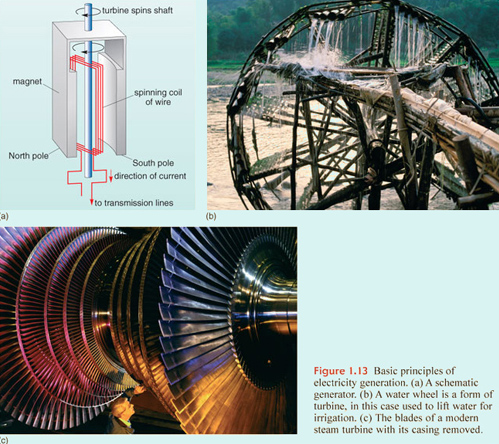6.2 Storing and transporting energy
To be useful to us, energy must be available where and when we want it, and in a form and in amounts we can handle. Severe weather systems concentrate natural energy wonderfully, but hurricanes associated with storm-force winds, driving heavy rain, thunder and lightning wreak havoc rather than top up our energy supplies.
Storing most forms of energy is very difficult. We have to re-heat our homes daily in the wintertime because they constantly lose heat, despite our attempts to insulate them. We cannot store light when the Sun goes down; we have to turn electricity into light until the Sun reappears. In fact, only two forms of energy are truly storable. Potential energy can be stored almost indefinitely by mechanical means, as in springs or lifted weights — the basis of clocks. Far more convenient is storage that exploits chemical energy — batteries, or even better, chemical fuel.
Fuels are compounds whose combustion liberates a large amount of energy per unit mass: they commonly have a high energy density. Wood was the major fuel before the Industrial Revolution, and remains the most important fuel for many non-industrial societies today. Wood, and other plants that can be used as fuels, produce biomass energy. As industry develops, energy demands grow and fuels with higher convertible energy content per unit mass are needed. Modern energy supply is centred on the fossil fuels: coal, oil and gas (Figure 1.4). Note that although the isotopes whose fission or fusion forms the basis for nuclear power are not burnt, they are generally known as nuclear fuels.
A further advantage of fuels as energy sources is their transportability, so that conversion can take place on selected sites or in mobile units. Highly concentrated fuels require less energy to transport than those with a low energy density but since lots of energy can be released accidentally from badly handled concentrated energy sources, care has to be taken to ensure that transport is safe. For some applications, such as cars, generating energy from stored chemical energy has the advantage of the ease of transport of small amounts of fuel.
Fossil fuels therefore represent extremely useful energy sources because they have a high energy density, they store energy for very long periods to be used when needed, and they can be transported simply and relatively safely.
A very important form of energy transport in developed countries is the generation and transmission of electricity. Figure 1.6 shows that around one-sixth of energy used in the UK is distributed as electricity via the National Grid. Since every primary energy source is used to some extent in generating electricity, a brief introduction to generators is useful (Box 1.2).
Box 1.2 Electricity generation
By far the greatest contribution to electricity supplies is made by exploiting the way in which an electrical current is induced in a conductor when it is moved through a magnetic field. Most such generators are made up of a cylindrical coil of conducting wire that is rotated between extremely strong magnets, so that an electrical current is induced in the coil (Figure 1.13a). There are other means, such as fuel cells and photovoltaic devices, but generators are common to conversion of most kinds of primary energy. Driving the rotation depends on harnessing energy released from primary energy sources through a specific form of engine, the turbine.

A turbine is a rotary engine driven by a moving fluid. A propeller on a boat or an aircraft, or a jet turbine, provides a driving force because of the design of its blades. A turbine used in electricity generation simply exploits the reverse of this effect. Moving 'fluid' provides the force that spins the turbine. The rotation transmits energy, and for electricity generation it is connected to a rotary generator. The simplest turbines have one moving part, as in windmills or water wheels (Figure 1.13b).
Electricity generation from flowing water or wind exploits the kinetic energy of the fluid. However, from the 19th century to the present day, the most common turbines used to generate electricity have been driven by high-pressure steam created by boiling water using coal, oil, natural gas, nuclear or geothermal energy (Section 5.1). In some electricity generating stations the moving fluid is the gas produced by burning oil or natural gas, in the manner of a jet turbine, thereby missing out the intermediary of steam and the associated inefficiency. The principle of a steam turbine is somewhat different from those used to harness the energy of wind and flowing water, and so too is its design (Figure 1.13c). Steam contains energy in three forms: as heat; as the energy needed to change water's state from liquid to gas ( latent heat of vaporisation); and as the energy bound up by the compression of a pressurised gas. The last is a form of potential energy, released when the pressure drops, as in the case of the air in a tyre when its valve is opened. Together, these three forms of contained energy are known as the enthalpy. The enthalpy of a gas is given by:

where H is enthalpy (in J), U is heat (including latent heat of vaporisation; in J), P is pressure (in pascals or kg m−1 s−2) and V is the volume of steam (in m3). (Note that pressure times volume — in kg m2 s−2—gives units in joules.) It is the PV term that provides much of the driving force for a steam turbine, because the pressure gradient across the turbine leads to rapid expansion of the steam and therefore high speed in the flow. Many steam engines, including the original piston engines invented in the early Industrial Revolution, also exploit the latent heat of vaporisation, by condensing the steam at the outlet of the turbine. The change of state from gas to liquid results in a near vacuum that increases the pressure gradient across the turbine — condensation adds 'suction' to the 'blowing' by steam. Latent heat is released and this can be 'recycled' in the generating system.
The late-20th century saw an increased reliance on electricity generation that uses natural gas as a fuel. Gas turbines are similar in design to those used in aircraft jet turbines. Turbines rotated by combustion gases have two important advantages over steam turbines: they are more efficient, and can be turned on and off very quickly, thereby suiting variable demand for electricity. Natural gas also contains a lower proportion of carbon than coal and oil, and so less carbon dioxide is emitted to the atmosphere.
